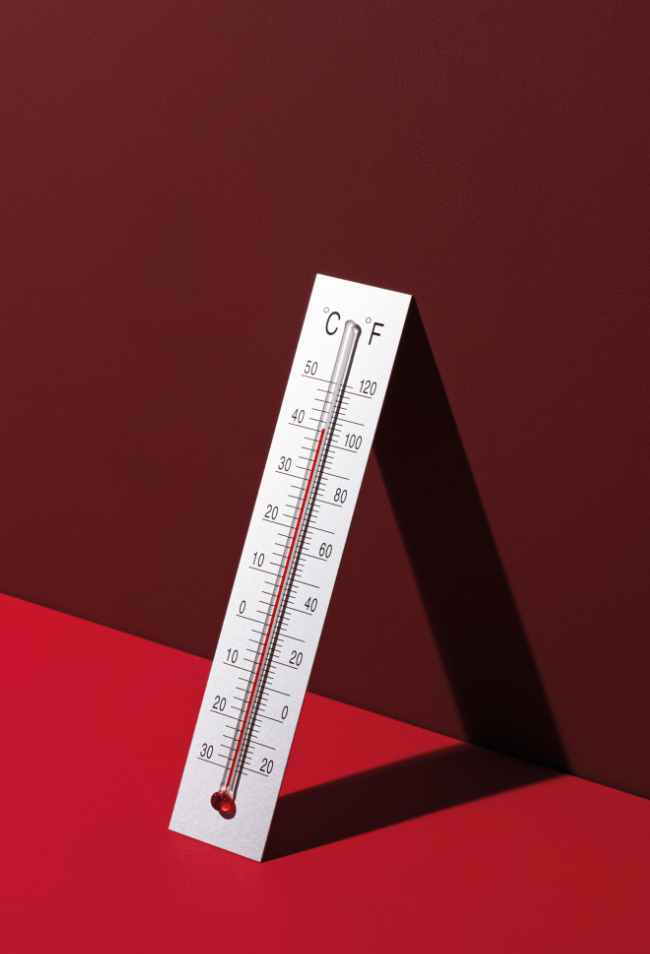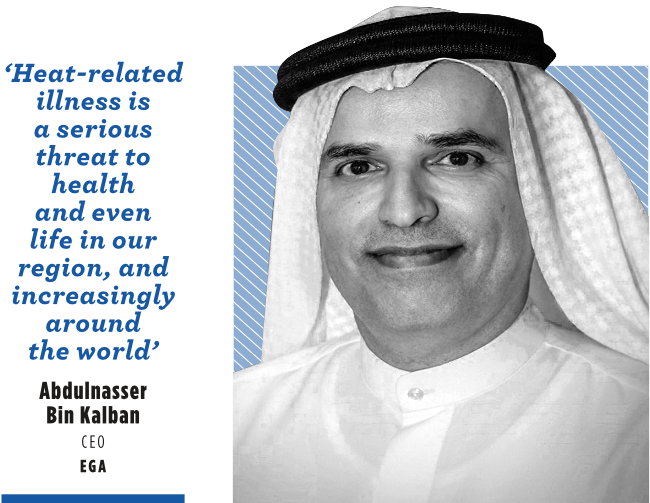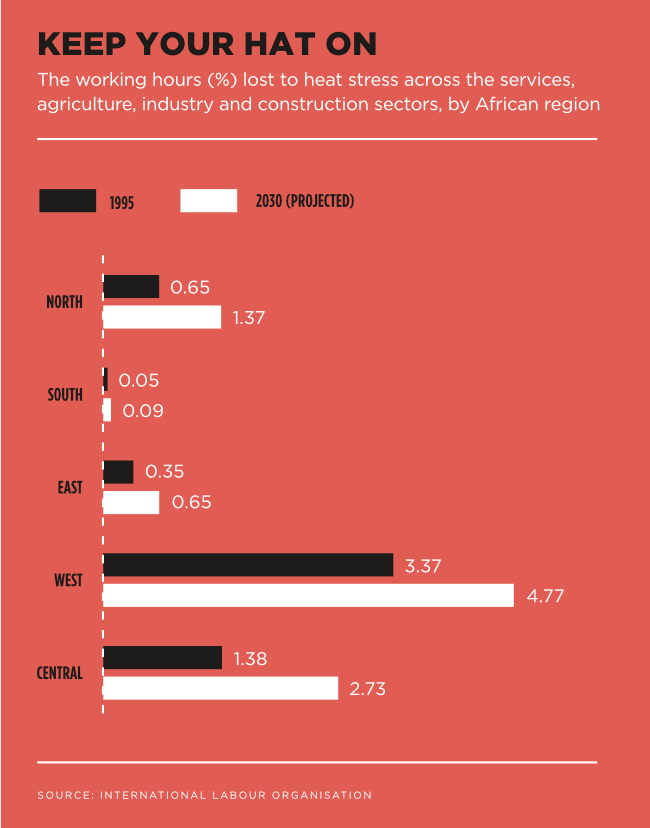The best examples are so skilfully made that they can be rolled up, passed through a wedding ring and then shaken out to resume their original shape without a single dent. They are so tightly crafted that they can be filled with water and leak not a drop. Only around a dozen people are left alive who can make the most exquisite specimens, the ‘Superfinos’ that may take one person four to six months of full-time work to produce. For about 150 years they have been an excellent yet simple means to mitigate the power of the sun’s rays by way of technology (admittedly it’s rather low tech). And (apart from weaves per square inch) it is still the same piece of equipment. From labourer to CEO, the Panama hat beats the heat. With style.
These days, however, in the face of climate change, extreme weather events – particularly heat waves – are posing a new and significant challenge to outdoor workers. As the frequency and intensity of extreme heat events increase, it becomes imperative for companies to turn to high tech to prioritise the well-being of these sorts of employees.
In many regions, workers are operating in environments characterised by dynamic weather patterns and varying microclimates. This variability necessitates a nuanced and personalised approach to managing heat exposure, considering factors such as humidity, wind speed and air quality. Traditional approaches to addressing heat stress, such as flexible work hours, may not sufficiently protect workers from the increasingly unpredictable and extreme weather conditions associated with climate change.
Workers exposed to the elements for extended periods are vulnerable to heat-related illnesses such as heat exhaustion and even heatstroke. Prolonged exposure to high temperatures can lead to dehydration, fatigue and impaired cognitive function. For employees operating heavy machinery, this can prove to be a lethal combination.
Studies have shown that above 20°C to 25°C, each rise in a degree of temperature is associated with around a 2% drop in task productivity. A research paper in the Climate Policy publication says that by 2030, the cost of lower labour productivity globally due to increased heat will be about £1.8 trillion a year.
To combat the situation many companies are turning to wearable devices equipped with environmental sensors. These can offer a promising solution by delivering personalised data, including temperature, humidity and air quality. Combined with monitoring software and backed up by AI number-crunching, they allow businesses to collect and analyse environmental conditions, offering workers a comprehensive understanding of the factors affecting their immediate work environment.
One such example was illustrated by the Dallas Morning News. At a construction site at Southern Methodist University last year, workers were equipped with sensors on their upper arms that monitored heart rate, body temperature as well as other biometric indicators, the newspaper reported. The sensors were linked to SafeGuard software. Readings for body function such as heart rate were linked to colour-coding (red, for example, for danger). If any level got too high, an alert was sent to a safety supervisor’s mobile phone.
‘We’ve known for years about heat illness, but training only gets us to a certain level,’ Ross Daly, director of safety at Rogers-O’Brien, the construction company involved, was quoted as saying. ‘This technology allows us to go a step further and monitor each other to be more proactive and not wait to start feeling sick to act.’
Wearable devices empower employees to make informed decisions about their outdoor activities by providing data that supports adaptive work scheduling. Farmworkers, for example, can receive real-time updates on weather conditions, allowing them to plan their tasks during periods of lower heat intensity or to schedule breaks during peak heat hours. This adaptive scheduling not only enhances productivity by optimising work hours but also minimises the risk of heat-related illnesses.
The personalised nature of wearable technology extends to providing individualised heat safety recommendations. By integrating the wearer’s health metrics, such as heart rate, hydration levels and personal tolerance to heat, the device can offer tailored advice on the duration and intensity of outdoor work. For instance, a worker with specific health vulnerabilities may receive more conservative recommendations, ensuring their safety in challenging outdoor environmental conditions. Or even in supercharged indoor workplaces.
CNN reported last year that at Emirates Global Aluminium (EGA), the largest industrial company in the UAE outside of the oil and gas industry, temperatures in the aluminium smelter warehouse can reach up to 58°C in the summer.
EGA has been running pilot programmes for a decade focused on eliminating heat-related illness. After trials with the Kenzen wearable technology platform, it announced last summer it was expanding the wearables project to 350 employee volunteers.
‘Heat-related illness is a serious threat to health and even life in our region, and increasingly around the world,’ EGA CEO Abdulnasser Bin Kalban stated in a press release. ‘Our work has shown that heat-related illness is entirely preventable, even in challenging industrial environments like ours. Wearable technology offers the potential to protect people even more.’
The device, which consists of a thin rectangular panel and a band, is wrapped around a worker’s upper arm. ‘Sensors on the panel measure heart rate, skin temperature, activity level and sweat output. Combined, this data is used to predict the wearer’s core body temperature – the amount of heat in a person’s blood and internal organs,’ according to CNN.
‘Once the core body temperature is above 38°C, when symptoms of heat exhaustion are likely to begin, the device vibrates and the user receives a notification on their phone, telling them it’s time to take a break.’
Plant managers have access to an overview of their team’s health via a real-time dashboard but it is limited to protect employee privacy.
‘If there’s a potential safety incident or an individual who needs an intervention, they – the supervisors – are given just the data to be able to intervene, nothing more,’ says Kyle Hubregtse, Kenzen’s CEO.
Kenzen says it has partnered with companies in construction, mining and manufacturing to implement this sort of technology in the workplace. EGA says its Beat the Heat programme is not restricted to wearable tech – workers are trained to detect the early signs of heat stress, not only in themselves but also in colleagues. The company conducts hydration tests before and during shifts, and employees are urged to take regular breaks and showers. In addition, cooling booths and drinking stations are also provided.
EGA’s executive VP of health, safety and environment, Salman Abdulla, told CNN that the wearables serve as an extra layer of protection. ‘Even without the device, if you are observing for yourself early telltale signs [of heat stress], there’s a set of procedures that employees here need to follow, such as going to a hydration station or cooling room,’ he says.
The main benefit of the wearable device, according to Abdulla, is that it is preventive. ‘It is objectively measuring their health conditions, and if at anytime a person is distracted, is not thinking, it provides an early sign that a person may be going into a heat stress condition.’
Heat stress is something Japan experienced last year in another sweltering summer. In July the average temperature was 28.7°C, the highest on record since 1875. At least 50 people died from heatstroke and about 50 000 needed emergency medical attention for heat-related issues during the hot spell.
As the home of high tech, Japanese companies have reacted with typical inventiveness to a warmer life, not only for outdoor workers.
Workman, known for its heavy-duty construction garb, launched a version of a jacket fitted with fans, for instance. Two small electric fans powered by a rechargeable battery are fitted into the back of the jacket, according to an AFP report. Retailing at 12 000 to 24 000 yen, the jacket sucks in air to deliver a breeze to the jacket-wearer’s body.
Toolmaker Makita, meanwhile, teamed up with textile firm Teijin and Osaka-based company Chikuma to invent a line of office wear (jackets and dresses) equipped with electric fans, while last year electronics giant Sony launched the latest version of its Reon Pocket, a wearable cooling (or warming) device worn inside the clothing that uses conductors powered by a battery to transfer heat.
Despite the novelty aspects of some wearables, the devices can be programmed to send notifications when certain thresholds for temperature, humidity or air quality are exceeded, prompting workers to take necessary precautions or adjust their activities accordingly. For example, if the heat index reaches a critical level, the device can alert the user to seek shade or hydrate to prevent heat-related illnesses.
Moreover, the integration of AI algorithms enhances the predictive capabilities of wearables. By analysing historical weather data and considering individual health metrics, the device can anticipate potential heat-stress risks and provide proactive recommendations. This proactive approach is particularly valuable in mitigating the cumulative effects of heat exposure over time.
Through thoughtful implementation and prioritising the privacy and accessibility of such technology, employers can create safer and more resilient work environments for outdoor workers who contribute significantly to SA’s agricultural, mining, tourism and industrial industries. Hats, however, will still be a necessity.










